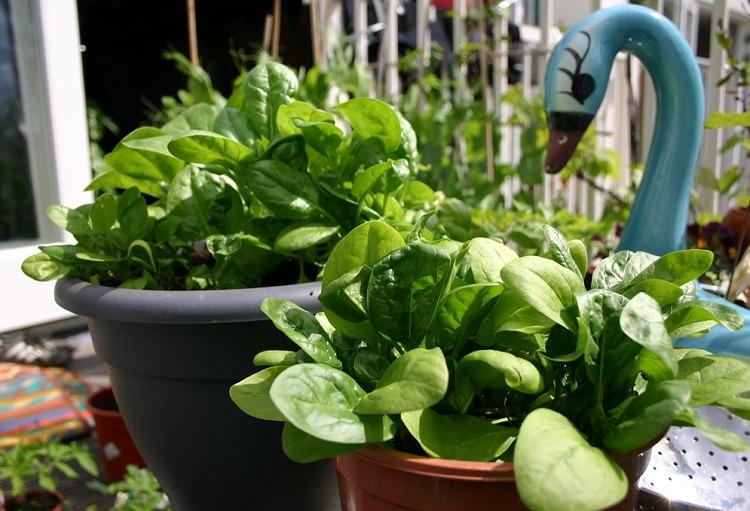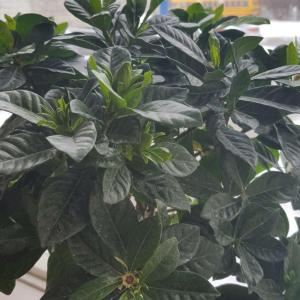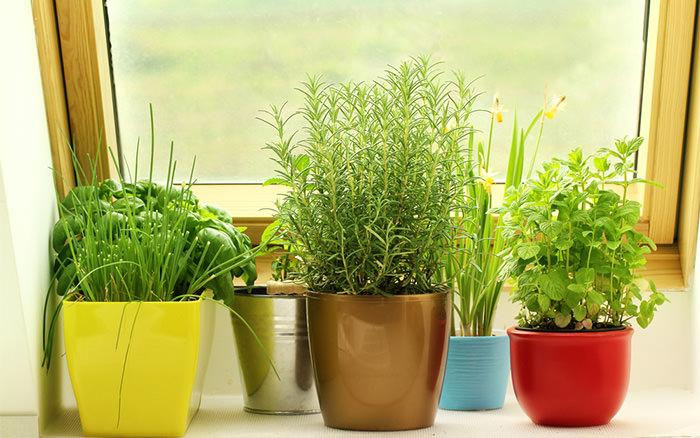文章
Mirella
2017年05月22日

Learn how to spinach in pots, it is one of the vegetables that you can grow in some shade and in any kind of space. Growing spinach in containers is easy too you can even grow it indoors on a windowsill.
USDA Zones— 3 – 11
Difficulty— Easy
Other Names— Spinacia oleracea (Scientific Name), Persian vegetable, palak, bōsī cài, 波斯菜, leafy greens
How to Grow Spinach in Pots

Growing Spinach in Pots from Seeds
Sow seeds 1/2 inches deep directly in containers or in a seed tray. Seedlings will germinate in 5-14 days depending on the variety and growing conditions. If you have sown seeds in a seed tray wait until 2-3 true leaves appear in each plant and then transplant them into the original pots carefully.
Choosing a pot
For growing spinach in pots, choose a pot that is least 6-8 inches deep. You don’t need a very deep pot rather use a wide pot. You can either use so many small pots and grow one plant in each or select large window boxes, wooden boxes or crates.
Spacing
Provide each spinach plant a space of 3 inches, if you want to pick large leaves give more space to each plant, 5 inches. If you want to harvest leaves at very young age, then this area can be reduced to 2 inches only. Divide the planter box into squares, and see how many plants will feel comfortable in it.
Requirements for Growing Spinach in ContainersPosition
If you are growing spinach in fall (autumn), keep the plant in a sunny spot (in mild climates) due to shorter days and less intensity of the sun. For spring and summer planting keep your potted plants in a location where it receives some shade, especially in the afternoon. In subtropical or tropical climate, place the containers in a spot that receives plenty of shade.
Soil
For growing spinach in containers, use quality potting mix rich in organic matter. The texture of soil must be crumbly and loamy. Avoid soil that clogs the drainage and remains waterlogged. Well-draining soil is most important factor for the optimum growth of spinach in containers. Soil pH must be neutral.
Watering
When growing spinach in containers avoid water stagnation because it will lead to the development of rot and various fungal diseases. Also, avoid wetting the foliage. Keep the soil moist but not soggy or wet. It is necessary to take care of good drainage in the pot.
Temperature
Spinach seeds germinate in temperatures as low as 40 F (4 C) and in high temperatures too. The best soil temperature for growing spinach falls in the range of 50-80 F (10-27 C). Many spinach cultivars can tolerate temperature down to 20 F (-6) and up to 90 F (32 C) easily. Once the temperature starts to soar high you may need to provide shade to your plants.
Growing Spinach Indoors

Growing spinach indoors on a windowsill is a great idea (as it doesn’t require a lot of sunlight) if you’re short of outdoor space. For this, buy a few 6 inches deep small pots and grow spinach in them. You can also grow herbs and annual flowers there.
Also Read: How to Make a Windowsill Herb Garden
Spinach Care
Growing spinach in pots doesn’t need special care. Regular watering, fertilizing and the right soil is the key to the great harvest.
Fertilizing
For growing healthy green spinach, you have to provide nitrogen. At the time of planting, you can mix time-based fertilizer or you can add a lot of compost or well-rotted manure, this will provide nutrients slowly. Feeding the plant with fish emulsion, compost or manure tea in the middle of the growth and so on is a nice organic way to promote the plants. If you have not done added time-based fertilizer, you can also feed the plant with balanced liquid fertilizer at regular intervals.
Mulching
Do mulching, even if you’re growing spinach in pots. Mulching plants with organic matter will help in retaining moisture.
Pests and Diseases
You don’t need to worry much about pests as you’re growing spinach in containers, in a small space and you can easily control them. However, keeping an eye on leaf-eating insects like slugs and caterpillars and other common garden pests like aphids will help you in eliminating them in time.
A Few Tips for Growing Spinach in Tropics
It is a cool season crop but growing spinach in tropics and subtropics is extremely easy, moreover, you can grow it successively as a bi-annual crop, except in hot summer months. You’ll need to provide it shade and enough water to keep the soil temperature cool and moist.
In warm weather, vegetables like lettuce and spinach begin to bolt early and start to set seeds. One of the most important thing you need to consider when growing spinach in tropics is to grow heat tolerant varieties (there are a lot of Asian varieties that are suitable for tropical climate) that grow slowly and do not bolt quickly. These varieties easily tolerate the heat and humidity.
Harvesting
The spinach plant will be ready for harvest 37-50 days after germination depending on the growing conditions and cultivar.
Harvesting can be done when the plant has formed at least 5-6 healthy leaves and they are at least 3-4 inches long. Pick outer leaves first and leave the new inner leaves so that they continue to grow or cut the whole plant off at the base with a knife or scissor, the plant will resprout again.
When the weather becomes humid and hot (in warm climates) the plant tends to form an erect stem, on which you can see some small yellow or green flowers developing. To coincide with the flowering and the subsequent production of flowers, the foliage of the plant thickens and changes in flavor (more bitter), which is called bolting so it is convenient to harvest the plant before it starts flowering for better taste.
USDA Zones— 3 – 11
Difficulty— Easy
Other Names— Spinacia oleracea (Scientific Name), Persian vegetable, palak, bōsī cài, 波斯菜, leafy greens
How to Grow Spinach in Pots

Growing Spinach in Pots from Seeds
Sow seeds 1/2 inches deep directly in containers or in a seed tray. Seedlings will germinate in 5-14 days depending on the variety and growing conditions. If you have sown seeds in a seed tray wait until 2-3 true leaves appear in each plant and then transplant them into the original pots carefully.
Choosing a pot
For growing spinach in pots, choose a pot that is least 6-8 inches deep. You don’t need a very deep pot rather use a wide pot. You can either use so many small pots and grow one plant in each or select large window boxes, wooden boxes or crates.
Spacing
Provide each spinach plant a space of 3 inches, if you want to pick large leaves give more space to each plant, 5 inches. If you want to harvest leaves at very young age, then this area can be reduced to 2 inches only. Divide the planter box into squares, and see how many plants will feel comfortable in it.
Requirements for Growing Spinach in ContainersPosition
If you are growing spinach in fall (autumn), keep the plant in a sunny spot (in mild climates) due to shorter days and less intensity of the sun. For spring and summer planting keep your potted plants in a location where it receives some shade, especially in the afternoon. In subtropical or tropical climate, place the containers in a spot that receives plenty of shade.
Soil
For growing spinach in containers, use quality potting mix rich in organic matter. The texture of soil must be crumbly and loamy. Avoid soil that clogs the drainage and remains waterlogged. Well-draining soil is most important factor for the optimum growth of spinach in containers. Soil pH must be neutral.
Watering
When growing spinach in containers avoid water stagnation because it will lead to the development of rot and various fungal diseases. Also, avoid wetting the foliage. Keep the soil moist but not soggy or wet. It is necessary to take care of good drainage in the pot.
Temperature
Spinach seeds germinate in temperatures as low as 40 F (4 C) and in high temperatures too. The best soil temperature for growing spinach falls in the range of 50-80 F (10-27 C). Many spinach cultivars can tolerate temperature down to 20 F (-6) and up to 90 F (32 C) easily. Once the temperature starts to soar high you may need to provide shade to your plants.
Growing Spinach Indoors

Growing spinach indoors on a windowsill is a great idea (as it doesn’t require a lot of sunlight) if you’re short of outdoor space. For this, buy a few 6 inches deep small pots and grow spinach in them. You can also grow herbs and annual flowers there.
Also Read: How to Make a Windowsill Herb Garden
Spinach Care
Growing spinach in pots doesn’t need special care. Regular watering, fertilizing and the right soil is the key to the great harvest.
Fertilizing
For growing healthy green spinach, you have to provide nitrogen. At the time of planting, you can mix time-based fertilizer or you can add a lot of compost or well-rotted manure, this will provide nutrients slowly. Feeding the plant with fish emulsion, compost or manure tea in the middle of the growth and so on is a nice organic way to promote the plants. If you have not done added time-based fertilizer, you can also feed the plant with balanced liquid fertilizer at regular intervals.
Mulching
Do mulching, even if you’re growing spinach in pots. Mulching plants with organic matter will help in retaining moisture.
Pests and Diseases
You don’t need to worry much about pests as you’re growing spinach in containers, in a small space and you can easily control them. However, keeping an eye on leaf-eating insects like slugs and caterpillars and other common garden pests like aphids will help you in eliminating them in time.
A Few Tips for Growing Spinach in Tropics
It is a cool season crop but growing spinach in tropics and subtropics is extremely easy, moreover, you can grow it successively as a bi-annual crop, except in hot summer months. You’ll need to provide it shade and enough water to keep the soil temperature cool and moist.
In warm weather, vegetables like lettuce and spinach begin to bolt early and start to set seeds. One of the most important thing you need to consider when growing spinach in tropics is to grow heat tolerant varieties (there are a lot of Asian varieties that are suitable for tropical climate) that grow slowly and do not bolt quickly. These varieties easily tolerate the heat and humidity.
Harvesting
The spinach plant will be ready for harvest 37-50 days after germination depending on the growing conditions and cultivar.
Harvesting can be done when the plant has formed at least 5-6 healthy leaves and they are at least 3-4 inches long. Pick outer leaves first and leave the new inner leaves so that they continue to grow or cut the whole plant off at the base with a knife or scissor, the plant will resprout again.
When the weather becomes humid and hot (in warm climates) the plant tends to form an erect stem, on which you can see some small yellow or green flowers developing. To coincide with the flowering and the subsequent production of flowers, the foliage of the plant thickens and changes in flavor (more bitter), which is called bolting so it is convenient to harvest the plant before it starts flowering for better taste.
0
0
成长记
Hong Lam
2017年03月14日

I moved Penelope to the windowsill now that it's less sunny. Fertilized her a tiny bit over the weekend. COME ON AND BLOOM JFC.


1
0
文章
Andy
2017年03月13日

Learn how to make a windowsill herb garden, if you’re short of space. Pleasure of harvesting your own herbs is immense– you can make fresh tea, use them in salads and garnish them on food.You don’t need a big yard for this, just a small and simple windowsill that receives a few hours of sunlight.

It’s easy and anyone who have lack of space can create a mini herb garden that grows on a window sill. Here are 6 basic steps to follow to make it possible.How to
Make a Windowsill Herb Garden
1. Choose Suitable Container to Make a Windowsill Herb Garden
Either use lot of pots to grow specific herb in each one or choose a planter as wide as that it’ll cover the space of your windowsill easily, make sure the pot you use should be at least 6 to 12 inches deep. Herbs are shallow root plants so they don’t mind growing in less deep planters. But most of the herbs like mint and thyme have tendency to spread, so it’s good to select a large and wide pot for them.
One more benefit of choosing a large pot is that you can pour lot of soil in it and this will save you from frequent watering.
2. Ensure sufficient drainage
Once you select a container or containers, second step is to ensure good drainage. Check out the bottom of planter for drainage holes, if they are not sufficient, make some.
You don’t need to put gravels or clay balls to make a drainage layer. This is a myth and doesn’t do any good for drainage.
3. Provide quality Potting soil
Soil or growing medium for growing herbs should be of best quality. It have to be light, penetrable, fertile and airy.
Buy soil less potting mix or make your own by adding perlite, compost and garden soil, it is the best growing medium for containers and essential for the success of your windowsill herb garden.
An aerated and rich soil with good retention power of the water improves the quality of plants you grow.
4. Planting a Windowsill Herb Garden
Be realistic and don’t try to grow all the aromatic and tastiest herbs you’ve heard about.
Make a list of herbs you would like to plant, and find out those which matches your growing conditions.
Forget about the species and varieties that are difficult to grow and spread more.
Choose basil, rosemary, thyme, oregano, cilantro and sage if your window is exposed to at least 6 hours of direct sun. If exposure of sun is less than this, prefer parsley, lemon balm, fennel, chives, chervil and mint.
These are the all time favorite herbs and easiest to grow, if you want to grow something out of the box, do some research.
5. Windowsill Herb Garden Care
Water your plants frequently in summer, in fall and winter limit the watering needs.
You can also add hydrogel crystals in soil and do heavy mulching to preserve water if you live in tropical climate.
To improve the quality and quantity of your crop, it is essential to use fertilizer regularly. Prefer organic fertilizers that provide all the necessary nutrients while being more environmentally friendly.
You’ll need nitrogen rich fertilizers to promote more foliage growth in herbs.
6. Harvesting
The best way to encourage the production of foliage and dense growth is to harvest herbs regularly, this frequent pinching and picking up of leaves promotes lush and healthy growth of plants.
You’ll also need to deadhead flowers to stop the herbs from seeding to prolong their growing time.
In addition, to add some colors on your windowsill herb garden, you can plant annual flowers that require similar growing conditions to grow.

It’s easy and anyone who have lack of space can create a mini herb garden that grows on a window sill. Here are 6 basic steps to follow to make it possible.How to
Make a Windowsill Herb Garden
1. Choose Suitable Container to Make a Windowsill Herb Garden
Either use lot of pots to grow specific herb in each one or choose a planter as wide as that it’ll cover the space of your windowsill easily, make sure the pot you use should be at least 6 to 12 inches deep. Herbs are shallow root plants so they don’t mind growing in less deep planters. But most of the herbs like mint and thyme have tendency to spread, so it’s good to select a large and wide pot for them.
One more benefit of choosing a large pot is that you can pour lot of soil in it and this will save you from frequent watering.
2. Ensure sufficient drainage
Once you select a container or containers, second step is to ensure good drainage. Check out the bottom of planter for drainage holes, if they are not sufficient, make some.
You don’t need to put gravels or clay balls to make a drainage layer. This is a myth and doesn’t do any good for drainage.
3. Provide quality Potting soil
Soil or growing medium for growing herbs should be of best quality. It have to be light, penetrable, fertile and airy.
Buy soil less potting mix or make your own by adding perlite, compost and garden soil, it is the best growing medium for containers and essential for the success of your windowsill herb garden.
An aerated and rich soil with good retention power of the water improves the quality of plants you grow.
4. Planting a Windowsill Herb Garden
Be realistic and don’t try to grow all the aromatic and tastiest herbs you’ve heard about.
Make a list of herbs you would like to plant, and find out those which matches your growing conditions.
Forget about the species and varieties that are difficult to grow and spread more.
Choose basil, rosemary, thyme, oregano, cilantro and sage if your window is exposed to at least 6 hours of direct sun. If exposure of sun is less than this, prefer parsley, lemon balm, fennel, chives, chervil and mint.
These are the all time favorite herbs and easiest to grow, if you want to grow something out of the box, do some research.
5. Windowsill Herb Garden Care
Water your plants frequently in summer, in fall and winter limit the watering needs.
You can also add hydrogel crystals in soil and do heavy mulching to preserve water if you live in tropical climate.
To improve the quality and quantity of your crop, it is essential to use fertilizer regularly. Prefer organic fertilizers that provide all the necessary nutrients while being more environmentally friendly.
You’ll need nitrogen rich fertilizers to promote more foliage growth in herbs.
6. Harvesting
The best way to encourage the production of foliage and dense growth is to harvest herbs regularly, this frequent pinching and picking up of leaves promotes lush and healthy growth of plants.
You’ll also need to deadhead flowers to stop the herbs from seeding to prolong their growing time.
In addition, to add some colors on your windowsill herb garden, you can plant annual flowers that require similar growing conditions to grow.
1
2
文章
Rainbow
2016年12月27日

#phalenopsis-orchids #moth-Orchids-care
1. Find the Perfect Location
Finding an area that receives bright, indirect light. A moderately bright windowsill or similar spot would be perfect. Phals grow beautifully in an east window and can be grown in a south or west window if protected by a sheer curtain.
PS:The color of the phal’s leaves is a good light indicator – if they are olive green then the plant is getting enough light, if they are darker it means it is not getting enough light.
2. Temperature
Phals will thrive best in a room with a daytime temperature of around 75°F and night temperature of 65°F .95°F is the maximum temperature recommendation. Although occasional deviations will not harm your plant, this can be a problem when it is in bud – chilly temperatures may cause the plant to stop budding.
3. Watering
The amount of water that your orchid needs depends mostly on the potting medium. Phals are usually grown in bark or moss, so if your orchid is potted in bark water once a week , if it is potted in moss, water when the top feels dry. Do not over-water.There are other factors that will determine your watering routine, like light and heat. For example, in the summer months the plant will need more frequent watering while in winter it will need less. Another thing to have in mind is that it is best to water your phal in the morning. Here is how the process should go: place the plant in the sink and use tepid water, let the water run through the plant for a minute or so and be sure to let the plant drain completely.
4. Humidity
Humidity is very important for moth orchids. They ideally require a humidity level of 55-75%. So how to increase moisture around your orchids? Simple place a shallow tray filled with pebbles and water under your plant. Make sure the pot does not sit in water as this will rot the roots.
5. Feeding
First rule about feeding your phal –do not over do it! Good results may be obtained by using any balanced orchid fertilizer. Feed your plant weekly. Once a month, use clear water to flush any accumulated salts from the potting mix.
6. Flowering
One of the things that makes Phals so popular is surely their blooming period which can last from 2 to 6 months. They are one of the longest blooming orchids. Phalaenopsis have also been known to bloom 2 to 3 times per year once they have reached a mature size. When the blooming period is over, don’t throw away your orchid because with just a little care it will flower again.
7. Care After Blooming
When all the pretty flowers fall out of your phal’s stem there are three options to consider leave the flower spike intact, cut it back to a node, or remove it entirely. If you leave it intact, it may produce new blooms from the tips. If you cut it back it may produce a new flower spike where you made the cut. If the existing stem starts to turn brown or yellow,hen remove it entirely. You can also trick your plant into bloom by placing it a cooler area where the night temperature is slightly lower, about 55°F. Once a bloom spike appears, return your orchid to its normal setting.
8. Repotting
As we said Phals are long term bloomers and will be in bloom for most of the year. When the flowers fall off, it is a good chance to repot your plant. It will be the best if this happens in spring or fall as the temperatures are mild and you will avoid unnecessary shock for the plant. Make sure you use a top quality orchid mix for repotting. Water sparingly until new roots are well established because a good root system ensures blooming.
9.Bud Blast
Bud blast is the main reason why some people think Phals are hard to maintain. Yes, it does happen – buds dry up and drop off the plants without ever opening. But there is always a reason for this and if you make sure you have everything right, you can avoid this. Some of the factors for bud blast are high room temperature, very low light, too much watering, too much fertilizer , using softened water etc. Your orchids love clean air! Exposure to smoke from an open fire, cigars, cigarettes, paint fumes and even old fruit (which exudes ethylene) can cause wilting and bud drop.
1. Find the Perfect Location
Finding an area that receives bright, indirect light. A moderately bright windowsill or similar spot would be perfect. Phals grow beautifully in an east window and can be grown in a south or west window if protected by a sheer curtain.
PS:The color of the phal’s leaves is a good light indicator – if they are olive green then the plant is getting enough light, if they are darker it means it is not getting enough light.

2. Temperature
Phals will thrive best in a room with a daytime temperature of around 75°F and night temperature of 65°F .95°F is the maximum temperature recommendation. Although occasional deviations will not harm your plant, this can be a problem when it is in bud – chilly temperatures may cause the plant to stop budding.

3. Watering
The amount of water that your orchid needs depends mostly on the potting medium. Phals are usually grown in bark or moss, so if your orchid is potted in bark water once a week , if it is potted in moss, water when the top feels dry. Do not over-water.There are other factors that will determine your watering routine, like light and heat. For example, in the summer months the plant will need more frequent watering while in winter it will need less. Another thing to have in mind is that it is best to water your phal in the morning. Here is how the process should go: place the plant in the sink and use tepid water, let the water run through the plant for a minute or so and be sure to let the plant drain completely.

4. Humidity
Humidity is very important for moth orchids. They ideally require a humidity level of 55-75%. So how to increase moisture around your orchids? Simple place a shallow tray filled with pebbles and water under your plant. Make sure the pot does not sit in water as this will rot the roots.

5. Feeding
First rule about feeding your phal –do not over do it! Good results may be obtained by using any balanced orchid fertilizer. Feed your plant weekly. Once a month, use clear water to flush any accumulated salts from the potting mix.

6. Flowering
One of the things that makes Phals so popular is surely their blooming period which can last from 2 to 6 months. They are one of the longest blooming orchids. Phalaenopsis have also been known to bloom 2 to 3 times per year once they have reached a mature size. When the blooming period is over, don’t throw away your orchid because with just a little care it will flower again.

7. Care After Blooming
When all the pretty flowers fall out of your phal’s stem there are three options to consider leave the flower spike intact, cut it back to a node, or remove it entirely. If you leave it intact, it may produce new blooms from the tips. If you cut it back it may produce a new flower spike where you made the cut. If the existing stem starts to turn brown or yellow,hen remove it entirely. You can also trick your plant into bloom by placing it a cooler area where the night temperature is slightly lower, about 55°F. Once a bloom spike appears, return your orchid to its normal setting.

8. Repotting
As we said Phals are long term bloomers and will be in bloom for most of the year. When the flowers fall off, it is a good chance to repot your plant. It will be the best if this happens in spring or fall as the temperatures are mild and you will avoid unnecessary shock for the plant. Make sure you use a top quality orchid mix for repotting. Water sparingly until new roots are well established because a good root system ensures blooming.

9.Bud Blast
Bud blast is the main reason why some people think Phals are hard to maintain. Yes, it does happen – buds dry up and drop off the plants without ever opening. But there is always a reason for this and if you make sure you have everything right, you can avoid this. Some of the factors for bud blast are high room temperature, very low light, too much watering, too much fertilizer , using softened water etc. Your orchids love clean air! Exposure to smoke from an open fire, cigars, cigarettes, paint fumes and even old fruit (which exudes ethylene) can cause wilting and bud drop.
3
2
kensong:Very good care guide for phals. Thanks a lot.




